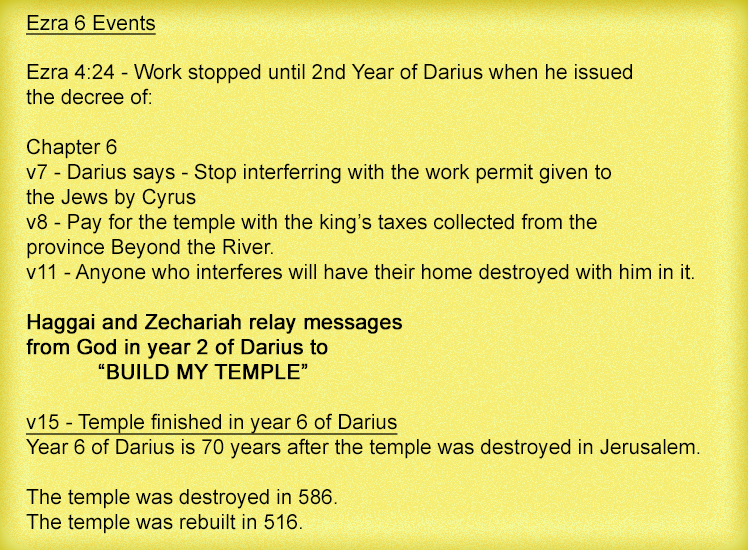This post can be downloaded as a PDF for easy printing.
If you would like to make comments on specific sections of this document you can do so in a shared Google Doc.
What starts the prophecy of Daniel 9:25?
Daniel 9:25 LEB And you must know and you must understand that from the time of the going out of the word to restore and build Jerusalem until an anointed one—a leader—will be seven weeks and sixty-two weeks; it will be restored and will be built with streets and a moat, but in a time of oppression.
Many books have been written in response to this question. Entire denominations have been established based on the answer to this question. Millions of people have had their faith in God strengthened based on the idea that this is a prophecy predicting Jesus.
Thousands of churches teach that the answer to this question is BC 457. Any challenge to this date is met with a full range of reactions from incredulity to hostility.
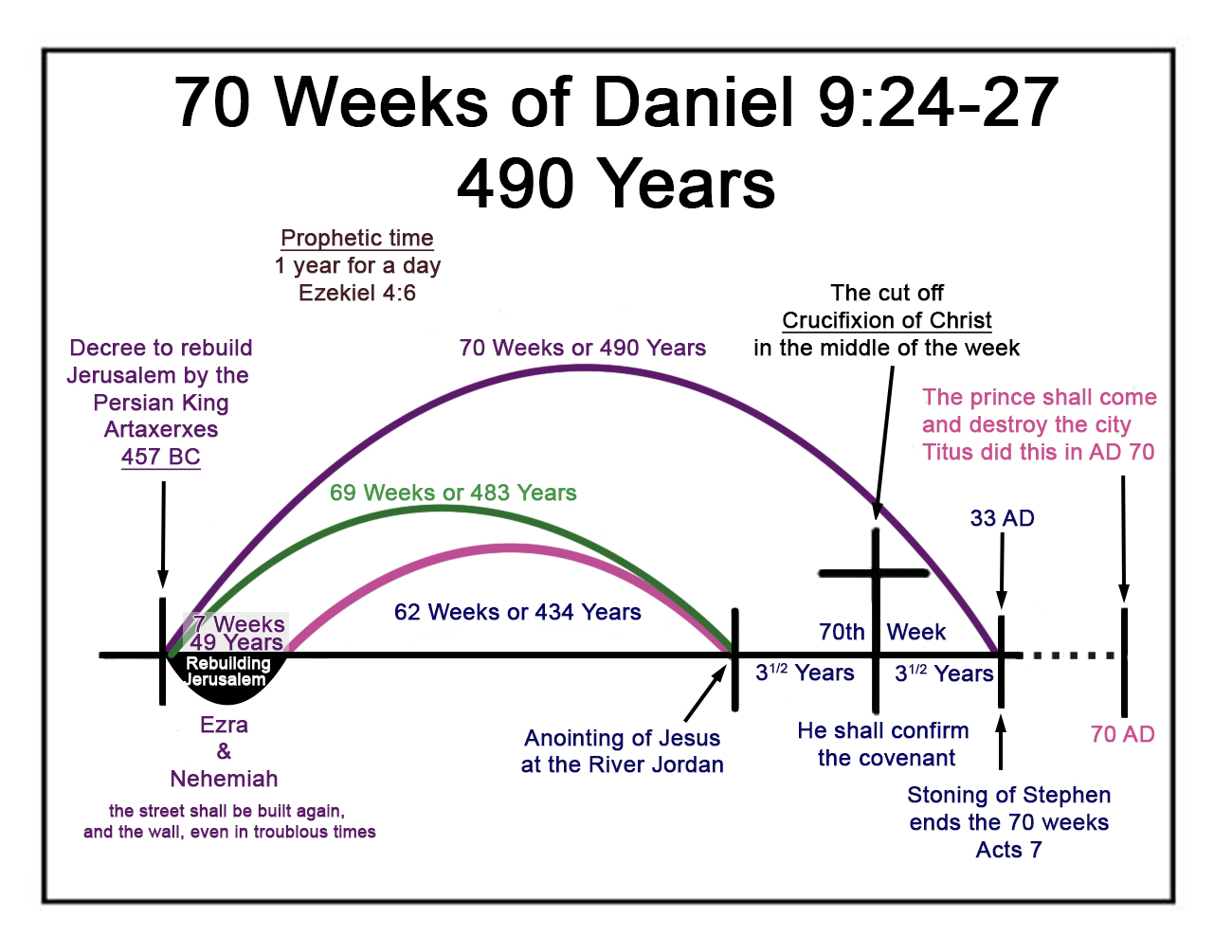
Some variation of this graphic is seen by everyone who studies Daniel 9.
There are two key events which never change, regardless of who is presenting the topic. One is the year BC 457, and the other is Jesus dying in the middle of the 70th week..
The question is whether the BC 457 date is correct. This paper explores when the instruction was given and by whom.
Who was the last high priest in Solomon’s temple when Nebuchadnezzar conquered Jerusalem and destroyed the first temple?
Answer: Seraiah
Credit – William Struse for his genealogy work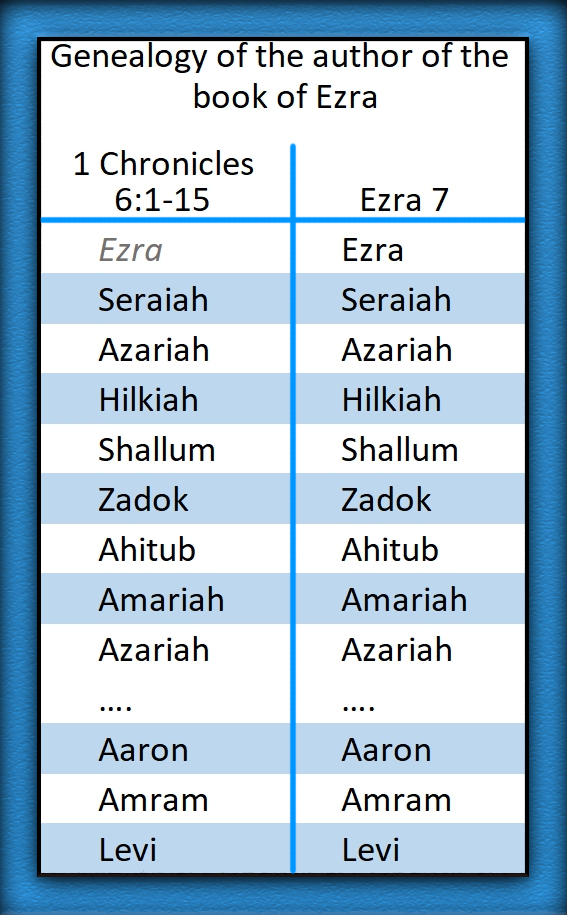
Seraiah was arrested and killed when Jerusalem was destroyed by Nebuchadnezzar. (2 Kings 25:18-21)
Seraiah had at least two sons. One was named Jehozadak, who was taken to Babylon as a captive. His other son was Ezra, who wrote the book of Ezra. Ezra was the son of the last high priest of Solomon’s temple. Ezra listed his ancestry in Ezra 7 and we can compare that to the genealogy given in
1 Chronicles 6.
Solomon’s temple was destroyed in 586 BC. It was in 586 that Seraiah was killed by Nebuchadnezzar.
Two of Seraiah’s sons were taken to Babylon. The reason we care is that this lets us know who wrote the book of Ezra, and it tells us under which Persian ruler it was written. The reason we care about these two things is that it tells us which dates we should use when we look at the prophecies given to Daniel by Gabriel in Daniel, chapter 9. The upcoming graphic helps us see who was in power in the various years that we are considering.
According to Jeremiah, the Jews were to be held captive in Babylon for 70 years. During this time, Jeremiah wrote a letter to the Jews in Babylon, telling them that God wanted them to cooperate with their captors because, as the captors prospeed, so would the captives. (Jeremiah 29:7)
During this captivity, a number of events happened that are very important — not only to the people who experienced them, but also to us today. Daniel, Jeremiah, Ezra, Nehemiah, Esther, and Nebuchadnezzar all wrote parts of our Bible. Cyrus and Darius played very important roles in the history of God’s people. Our most important prophecies come from this time. It is what was written during this time that Jesus tells us to look to for a better relationship with Him.
Was Seraiah really the father of Ezra? Many Bible commentators will tell you that Ezra was not the son of Seraiah.
If Ezra was alive when the temple was destroyed in 586 BC and in BC 457, then he would have been at least 129 years old — or more likely 140 or 150 — in BC 457. Everyone agrees that humans didn’t live to be that old after the days of Moses.
This leaves many commentators with a problem. There is a desire by many for the events of Ezra 7 to happen in the year BC 457 so that the prophecy of Daniel 9:24-27 can be used as a prophecy foretelling Jesus. Others want to use 457 as a start date for the 2,300 evenings and mornings of Daniel 8:14. The year 457 as the year for the decree to build and restore is an extremely important foundation for many people.
So, there are two options.
- The first option is that Ezra was the son of Seraiah. And, we’d need to read the events of Ezra 7 as having happened in the reign of Artaxerxes Darius in the year 515 BC. If we do this, Ezra would be at least 71 years old and more likely 81 or 91 when he reads the law in Jerusalem as described in Ezra 7.
- The second option is that we would need to read that the events of Ezra 7 happened in the reign of Artaxerxes Longimanus in the year BC 457. This would mean that Ezra did not accurately name his father.
For many commentators, making sure that the events of Ezra 7 happen in BC 457 causes them to decide that the genealogy of Ezra must be inaccurate.
It is not uncommon for genealogy lists in the Bible to skip generations. In Zechariah 1:1, we are told that Zechariah is the son of Berekiah who is the son of Iddo. In Ezra 5:1 and Ezra 6:14, we are told that Zechariah was the son of Iddo. Berekiah is not mentioned. If the only thing we had to go on was the genealogy of Ezra, we would not be able to state with certainty that the author of Ezra was alive in 586 when the 1st temple was destroyed.
For many commentators, BC 457 is more sacred than the accuracy of Ezra 7:1.
However, the genealogy of Seraiah is a minor challenge compared to the prophecy of Jeremiah 29:10.
While God’s chosen people were in exile in Babylon, the prophet Jeremiah wrote a letter. He sent the letter from Jerusalem to Babylon, giving instructions from God about what the exiles were to do. Along with this, God told the exiles that they would be captives for 70 years.
The 70 years began when Nebuchadnezzar’s general destroyed the temple and took thousands prisoner in 586. The story can be found in 2 Kings 25.
When does the word to restore and build Jerusalem occur? There are four times when decrees are issued in the books of Ezra and Nehemiah. These are highlighted with our numbers 1 through 4a. There is universal agreement that the temple was destroyed in BC 586 or 587. The difference is dependent on whether the new year began in the Fall or Spring. Here, we will use the most commonly used year for the destruction of Jerusalem and the temple. We will also use the Spring as when the new year begins, as directed by God when the Hebrews left Egypt.
We will examine each of the decrees. Our goal is to identify the year in which the decree to restore and build Jerusalem occurs.
Nebuchadnezzar caused the destruction of Jerusalem. It is he who caused thousands of Jews to be killed and exiled. He also wrote some of our Bible. The captivity began in the 19th year of Nebuchadnezzar.
During the 70 years of captivity, there was a succession of rulers of the Babylonian and Persian empires. After Nebuchadnezzar died, there were four more Babylonian rulers. Three of them are shown in our graphic. One is not shown, as his time was so short. The font for Amel Marduk and Nerigliassar is small because they do not play a role in the story.
Nabonidus is the father of Belshazzar. Nabonidus apparently didn’t enjoy being ruler and spent his time restoring temples in places far away from the palace. He is also the first known archeologist. Belshazzar was responsible for running the empire while his dad was away.
The dates we use come from a variety of sources; but they are based on the clay tablets that were found at the Assyrian and Persian ruins and from the histories written by the Greeks.
Cyrus issued the most famous decree, which we find referenced in Ezra 1. He issued this decree, allowing the Jews to return to Jerusalem 23 years before God had told them they would be freed from captivity.
Cyrus issued his decree in BC 539. It was given during his first year of rule. The story can be found in Ezra 1.
Ezra 1:1-4 LEB “In the first year of Cyrus king of Persia, in order to accomplish the word of Yahweh by the mouth of Jeremiah, Yahweh stirred the spirit of Cyrus king of Persia and he sent a message to all of his kingdom and also put the message in writing: 2) “Thus says Cyrus king of Persia: Yahweh, the God of the heavens, has given me all the kingdoms of the earth. And he himself has appointed me to build a house for him in Jerusalem, which is in Judah. 3) Whoever among you who is from all of his people, may his God be with him and may he go up to Jerusalem, which is in Judah, and may he build the house of Yahweh, the God of Israel. He is the God who is in Jerusalem. 4) And let every survivor, from wherever he resides be assisted by the men of that place with silver and gold, with possessions and domestic animals, and with the freewill offering for the house of God which is in Jerusalem.””
The decree by Cyrus is an attractive start date for the Daniel 9:25 prophecy. It is an interesting story. It has a date that we can use. But, most Bible students choose not to use this date (539) because it doesn’t get us to Jesus, and that is the end goal for many. It also does not match the prophecy of Jeremiah, which has the Jews captives for 70 years. When Cyrus issued the decree, the Jews had only been in captivity for 47 years. They had another 23 to go. We will return to the decree by Cyrus.
Another series of decrees were issued in the year BC 520, which was the second year of Darius’ rule. Ezra 6 gives us the story of the governor of the province Beyond the River, also called Trans Euphrates, and also called Eber-Nari. The governor sent a letter to the new ruler asking Darius if he wanted to continue to block the work on the new temple in Jerusalem, as the previous Artaxerxes had done. Darius responds with explicit instructions that, instead, the block would be removed and the decree by Cyrus would be upheld. He added funds to make sure it was done. Darius also included a threat to anyone who attempted to interfere with the temple being built.
We also learn, in verse 15 of chapter 6, that the temple is completed in year 6 of Darius, which is the year BC 516.
The temple was destroyed in 586
The 2nd temple was completed in the year 516
There were seventy (70) years between the destruction of the 1st temple and the completion of the 2nd temple.
Part of the reason that Darius confirmed the decree of Cyrus is that, when he took power, there were a lot of people challenging his rule. So, Darius emphasized that he had a common ancestor with Cyrus. He was appealing to the loyalties of those who followed Cyrus by confirming the decrees of Cyrus.
But, even more important than the confirmation by Darius that the decree of Cyrus should be honored is what we find in the book of Haggai. It is a short book with only two chapters; yet, in that book, we find God Himself issuing an instruction to build the temple in Jerusalem. God sends this message to those charged with building the temple in the same year that Darius confirms the decree of Cyrus.
Here, we quote all of the book of Haggai. We emphasize the sections that tell us when God gave this message and what the message was.
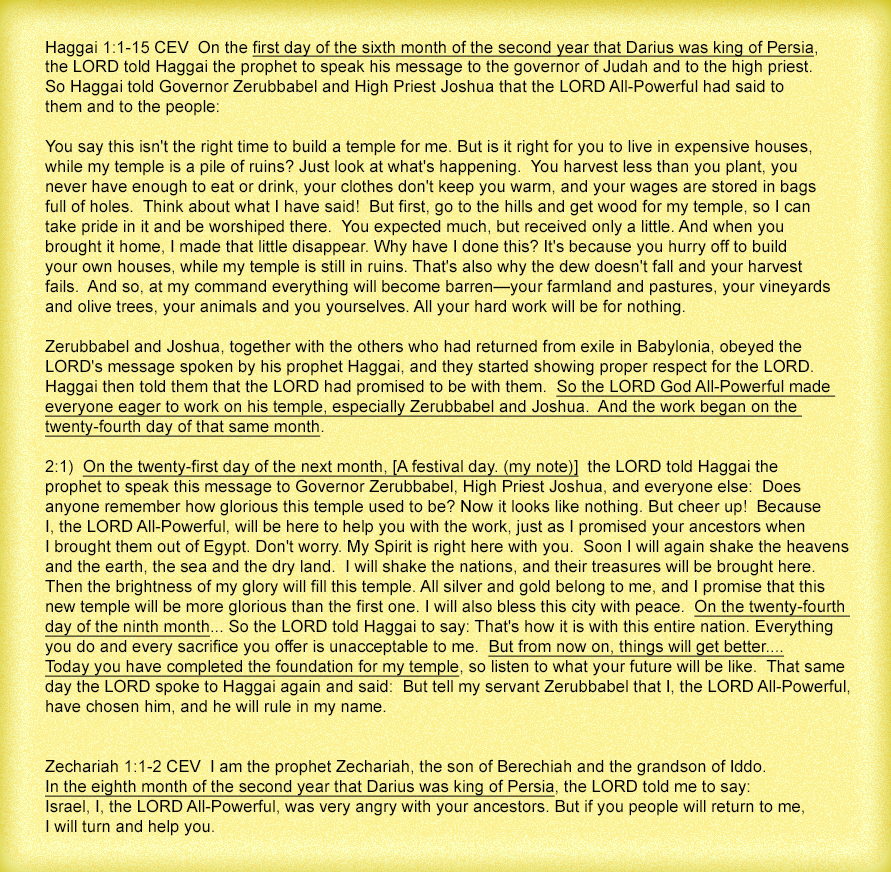 To summarize, we have decrees issued in two years so far.
To summarize, we have decrees issued in two years so far.
- Cyrus – BC 539 – Rebuild
- Darius – BC 520 – Confirm the Cyrus decree
- God – BC 520 – Inspires people to build His temple
Ezra 6:15 tells us the temple is completed in the 6th year of Darius.
It would seem that the decree to restore and build would be given before, not after, the temple is completed.
Next, we look at the decree that we find in Ezra 7. This is the basis for most evangelistic series and sermons on the topic of the Daniel 9 prophecy.
Darius ruled for 36 years. In the graphic, each year is marked with a white dot.
In year one of Darius’ rule, Daniel had his vision and interaction with Gabriel, which is our focal point.
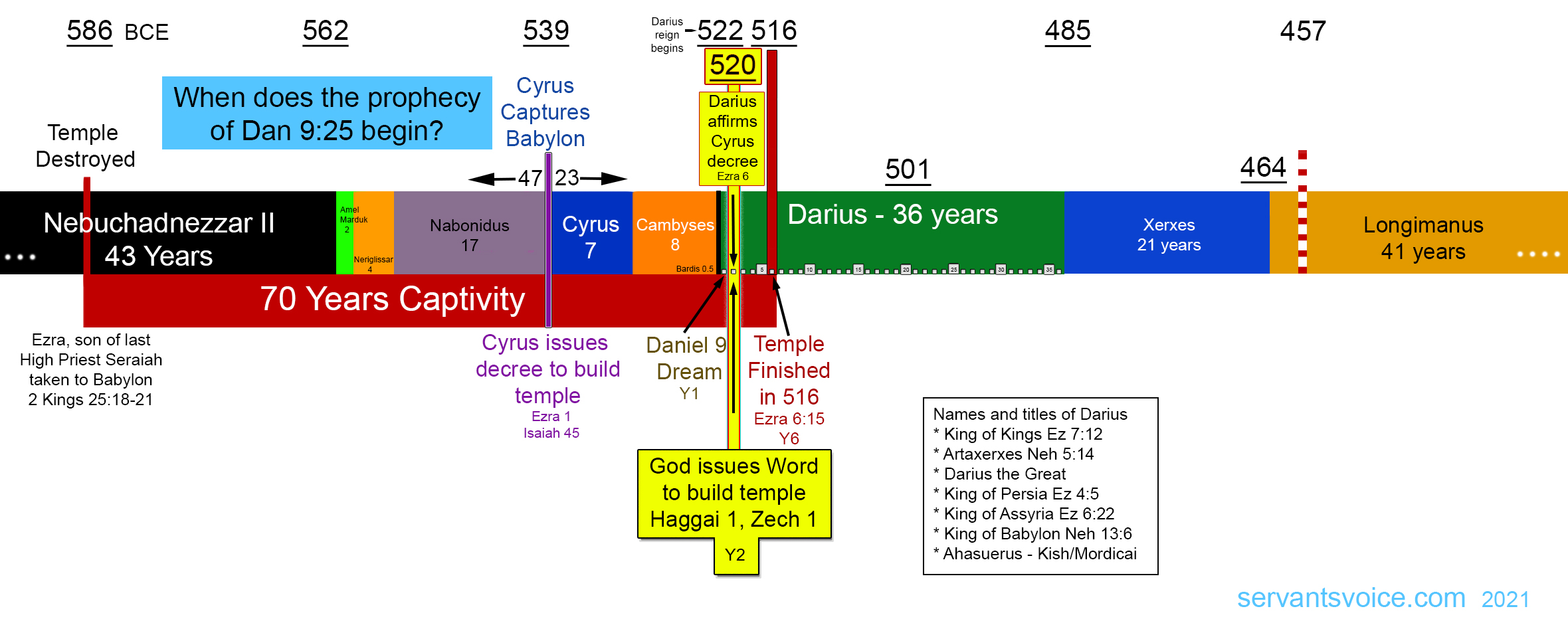 Ezra chapter 7 does not include any instructions to build. Rather, the decree we find in chapter 7 is an emancipation act freeing all Jews from their captivity in Babylon.
Ezra chapter 7 does not include any instructions to build. Rather, the decree we find in chapter 7 is an emancipation act freeing all Jews from their captivity in Babylon.
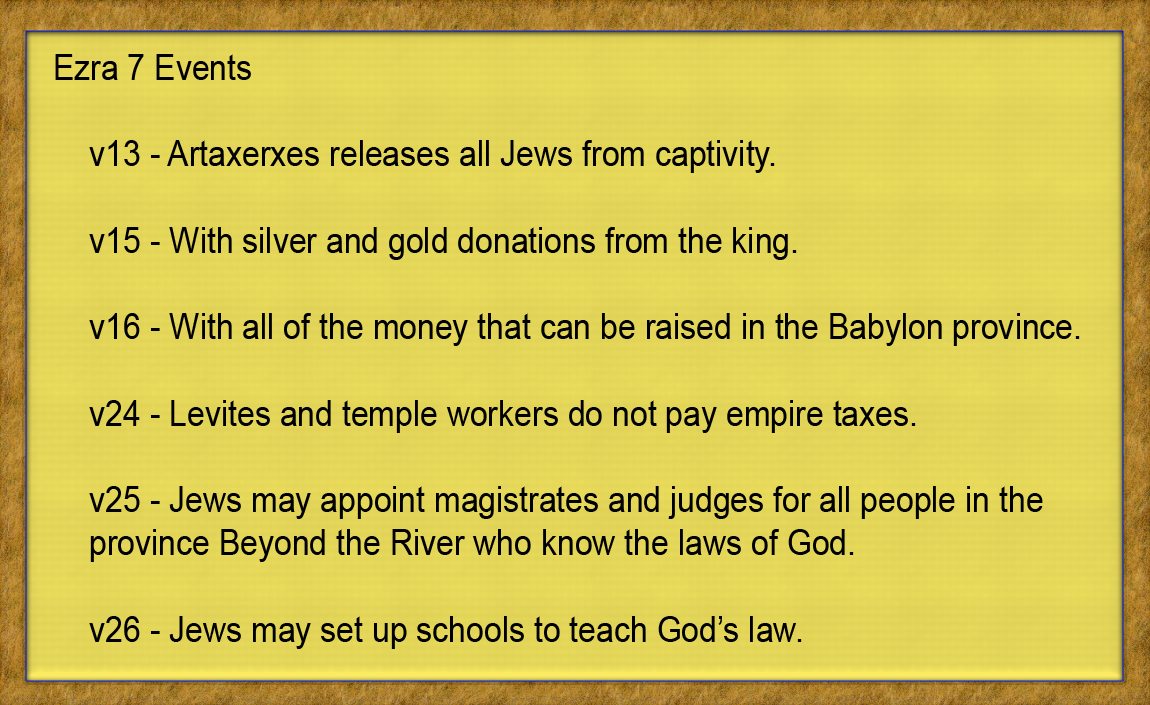 The question is: when does this emancipation happen? Does it happen immediately after the 70 years of captivity, or after 129 years of captivity?
The question is: when does this emancipation happen? Does it happen immediately after the 70 years of captivity, or after 129 years of captivity?
Ezra 7:8 tells us that the emancipation happens in “the seventh year of the king.”
Ezra 6:15 tells us that the temple was completed in the last month of the 6th year of king Darius.
Some suggest that there is a 58-year gap between Ezra 6 and Ezra 7.
I believe a more accurate way to read it is that, on the first day of the following month, Ezra set out for Jerusalem with everyone who wanted to leave. This would be day 1 of the first month after the temple had been completed.
The temple was destroyed in 586. It was rebuilt in 516, which was 70 years after the temple was destroyed. Less than a month later, Darius issued the decree we find in Ezra 7 which:
- Frees all of the Jews at the end of the 70 years.
- He makes a donation of silver and gold.
- He allows a fundraising drive in Babylon. In Haggai 2:7 God says that He would shake the nations and cause the treasure of all nations to come to Jerusalem.
- He allows the Jews to appoint their own judges so that they are no longer ruled by their enemies.
- They are allowed to set up schools to teach people God’s law.
Which makes more sense to you? Should we read Ezra 7 to happen at the end of the 70 years of captivity, or should we place it 58 years later?
Jeremiah says that the Jews would be captive for 70 years. If we place Ezra 7 in the 7th year of Artaxerxes Longimanus, then they would have been captive 129 years, not 70.
Ezra 7 does not have a decree to restore and build Jerusalem. It is a decree to release the captives.
I believe that the 70 years of captivity ended with the completion of the temple in BC 516 and the travel in BC 515.
The return to Jerusalem was a second Exodus with everyone freed from Babylon. They would have had all of their belongings and wagons of silver and gold. Ezra 8 tells us they had about 50,000 pounds of silver and 8,000 pounds of gold. That treasure was guarded by God. There would have been a number of older people in the group. They would have moved slowly. Their travel took four months.
We have another decree to consider. This is the decree that we find in Nehemiah, chapter 2. It was year 20 of King Artaxerxes. The wall still had gaps. This is either 14 years after the temple was completed in 516, or it is 72 years later in 444.
Nehemiah had been the king’s cupbearer or wine taster –“Take a sip of that and tell me if it has been poisoned.”
The king must have liked him, as he gave Nehemiah “letters” which authorized him to take from the Governor of the province whatever he needed to repair the walls. Along with being given the authority to repair the walls, Nehemiah was made governor of Jerusalem for 12 years.
He returned to Jerusalem and, within 52 days, repaired the walls that had been in disrepair for a long time. Why did the walls still have gaps for years? Remember one of the arguments that was presented by the enemies of Jerusalem was that if the walls were repaired, it would be harder to force them to pay their taxes should they become rebellious like they had a history of doing.
However, the king trusted Nehemiah and allowed him to repair the walls. Nehemiah named the people who were involved in helping repair the walls. In the list of names, we find some who were released by Cyrus in BC 539. Since we are choosing to accept the idea that people in the era might have a hard time remembering who their father is, we look for other evidence to decide which Artaxerxes Nehemiah is referring to.
We know that Ezra and Nehemiah are contemporaries. When the wall was completed in the 20th year of the king, Ezra led a choir procession around the top of the wall in one direction, and Nehemiah led another choir procession around the wall in the other direction. (Nehemiah 12) The Ezra who led the procession of freed Jews in Ezra chapter 7 immediately upon the completion of the temple was still alive and leading the choir around the wall in the year BC 501. He would have been at least 85, and that assumes that he was taken from Jerusalem to Babylon while a fetus. If he was taken when he was 13, he would have been 98 as he led the choir around the wall.
Persia exacted tribute from the provinces of its empire. Egypt sent silver and grain. India sent timber and gold. The province of Beyond the River sent gold and timber. Scythia sent 100 eunuch boys each year. We are told that Daniel was managed by the master of the eunuchs. The empire pulled people from across the empire to fill its armies and to administer the empire. Ezra was known as a scribe. His job was to mark clay tablets with the affairs of the state.
This graphic considers how things would look if we decide that there was a 58-year gap between Ezra chapter 6 and chapter 7. The box in the bottom right reports how many years would elapse between various events, in BC 515 or BC 457.
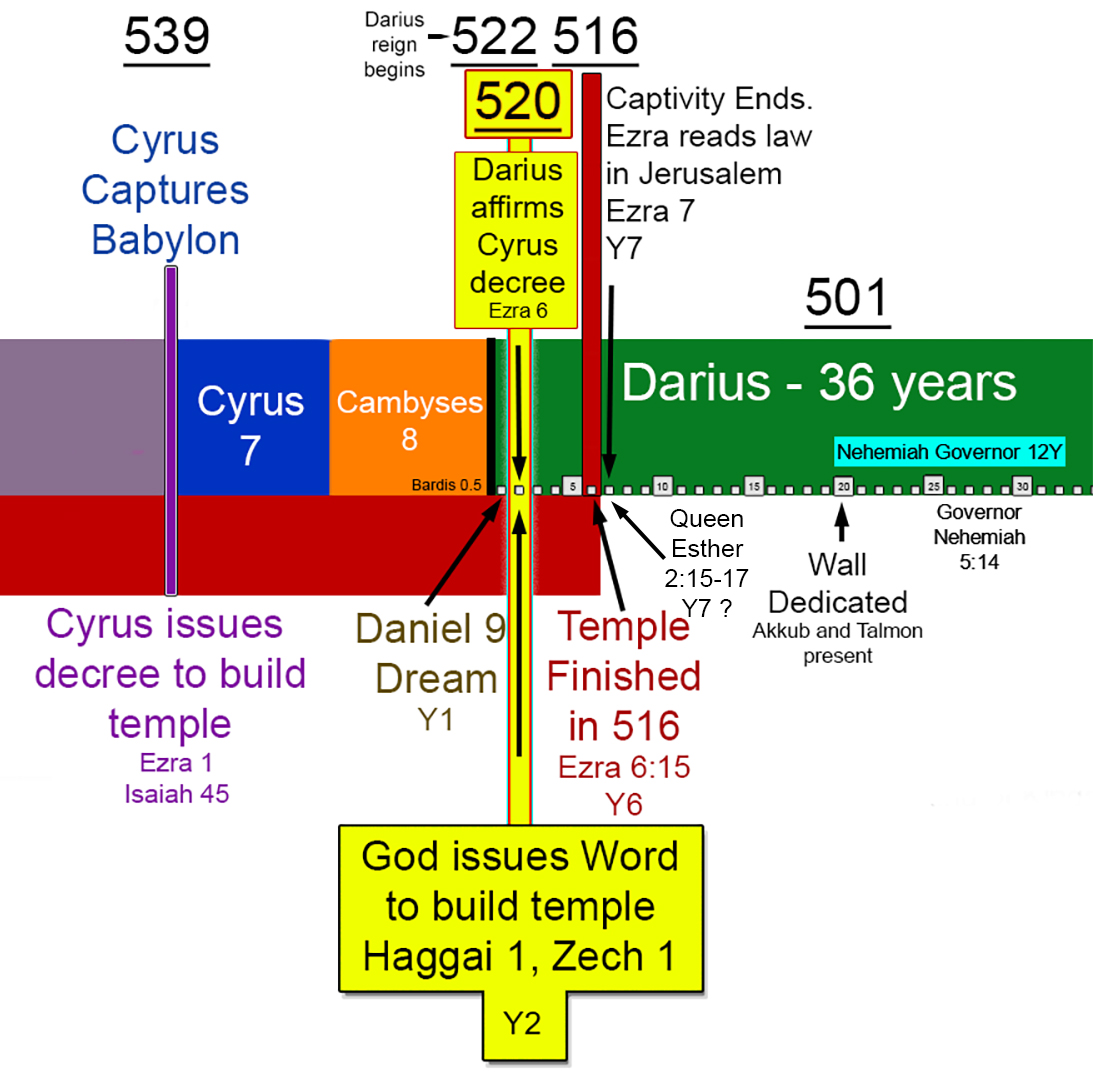 Haddassah, aka Esther, became queen in the 7th year of one of the kings. Of the Bible scholars who believe her story is true (most don’t), most choose to put her story in the time of Xerxes, the son of Darius. I believe her story fits best with the timeline and events of the life of Darius. Whether you place her story here or 36 years later, we know that the reign of Darius was of major importance in the story of the Jews.
Haddassah, aka Esther, became queen in the 7th year of one of the kings. Of the Bible scholars who believe her story is true (most don’t), most choose to put her story in the time of Xerxes, the son of Darius. I believe her story fits best with the timeline and events of the life of Darius. Whether you place her story here or 36 years later, we know that the reign of Darius was of major importance in the story of the Jews.
The idea that we should use BC 457 as the starting point was suggested by George Rawlinson. He translated the writings of the Greek historian Herodotus. He worked with his brother, Henry, and completed the translation in 1860. He wrote a number of histories and contributed to religious commentaries.
His brother, Henry, was an officer in the British East India Company army. The British government had army officers embedded in the company and provided protection for the company’s interests. The British government saw the company’s interests as national interests.
Henry Rawlinson transcribed the Persian portion of the Behistun inscription. He spent many years in Iran and was responsible for helping us learn how to translate the clay tablets..
His brother, George, translated the works of the Greek historian Herodotus. Herodotus is called the Father of History, as he was the first to have collected stories and arranged them in a narrative form. Herodotus was born in the Persian empire during the reign of Longimanus. Herodotus was Greek and wrote from the Greek perspective. He also reported that he didn’t always believe what he wrote but was just relaying things that he heard.
The Rawlinson brothers were major contributors to our understanding of the Persian empire. Their translations of Greek and Persian are very important and provide us with much of our secular understanding of the era.
As a part of George Rawlinson’s commentary on the family of the Achaemenids — which Darius, Xerxes, and Longimanus were are part of — he said that Herodotus mentioned Longimanus once but that there was every reason to believe that it was this Artaxerxes who sent Ezra and Nehemiah to Jerusalem. (History of Herodotus volume 4, page 217) George published this in 1860.
The idea was picked up twenty years later by Robert Anderson, who was a preacher. He suggested in his 1881 book, the Coming Prince, that we should use the year 457 as the starting date for the decree to restore and build Jerusalem. Credit William Struse for his research on the origin of the idea.
This supposition became popular with much of Christiantity because it allowed the seventy sevens of Daniel 9 to be used as a prophecy to foretell Jesus.
Artaxerxes Longimanus began his reign in 464 or 465. Rawlinson said 465. According to popular theology, the decree to restore and build Jerusalem started 59 years after the temple was actually finished and 44 years after the walls of the city were actually completed and dedicated. The popular theory (that uses BC 457) has the year of the decree to allow all of the Jews to return home, which then causes the Jews to have been captive for 129 years.
This is not logical. The only reason we use BC 457 is because we need this date to be correct, regardless of any evidence to the contrary. We do this so we can use Daniel 9 to foretell Jesus.
All of us are prone to confirmation bias where everything we see is interpreted to confirm what we want. Be careful that this is not happening to us as we study.
A summary of the things we have shown:
- Daniel was given the prophecy of Daniel 9:24-27 after the decree of Cyrus in BC 539 and before God’s word to build the temple.
- In BC 520, God instructed His chosen people to build His temple. In BC 520, God also inspired Darius to confirm the decree of Cyrus. This was 19 years after the decree of Cyrus.
- Four years later, in BC 516, the second temple was completed. The second temple was completed 70 years after the first temple was destroyed.
- The decree of Ezra chapter 7 does not include any instructions to build. Instead, Ezra 7 is an emancipation proclamation. In less than 30 days after the temple was completed, all Jews were released from Babylon and allowed to return to Jerusalem. This was 70 years after they were exiled. This was when the prophet Jeremiah said they would be allowed to return.
- There is no evidence that the Jews were held captive for 129 years, as they would have been if we place Ezra 7 in the era of Artaxerxes Longimanus.
- The temple building was finished in BC 516. The wall was repaired in BC 501. A decree in BC 457 to restore and build something which had already been built and dedicated doesn’t make sense.
We have demonstrated from the Bible that the decree to restore and build the second temple happened in either BC 539 with a decree by Cyrus or in BC 520 with the Word of God to Haggai and with the confirmation by Darius of the Cyrus decree. We have no evidence that any decree to build something that was already built and dedicated happened in BC 457. In fact, we have Biblical evidence that no such decree would have been given in BC 457.
If we use the decree by Cyrus in 539 or the Word by God in 520, then the way we typically use the prophecy of Daniel 9:25 does not get us to the birth or ministry or death of Jesus. Yet, for many people, this is a must. Anything that fails to associate the Daniel 9:25 prophecy with Jesus must be wrong.
This causes us to ask, “Are we so determined as to what an answer must be that we are willing to believe something that cannot be? How many contortions are we willing to go through in order to get an answer we want?”
We have several options in dealing with the start date.
- Decide that BC 457 is correct, regardless of any evidence otherwise.
- Decide that the 70 sevens of Daniel 9 are not 490 years but some time unit other than years.
- Decide that Daniel 9 is not a prophecy that takes us from the building of the 2nd temple to Jesus but, rather, that it has some other purpose.
- Decide that it is too complicated — too difficult — to understand and that the only thing that matters is that we love our neighbor and let someone else worry about this faith-shaking problem.
Our understanding of what time period is associated with “the word to restore and build Jerusalem” should strengthen our faith and relationship with Jesus. Knowledge and understanding brings us closer to God.
Daniel 9:25 LEB And you must know and you must understand that from the time of the going out of the word to restore and build Jerusalem until an anointed one—a leader—will be seven weeks and sixty-two weeks; it will be restored and will be built with streets and a moat, but in a time of oppression.
Deciding that something is true even when the evidence says otherwise doesn’t make us stronger.
When we decide that Daniel 9:25 must get us to Jesus regardless of what the text says, we ignore anything in the text that doesn’t support our desires.
Ask yourself, why must the Daniel 9:25 text go from a Persian ruler to Jesus? Why is that interpretation a requirement? Can we consider any other options? If the answer is that there is only one way to understand it, regardless of the evidence, then we are choosing to ignore the Bible and exalt our own theories.
When Jesus was on Earth, He tried to convey the idea that He was here for a reason that was very different than what most people could accept. Many Jews had an expectation of what their Messiah would do. When He didn’t match that expectation, many rejected their Savior. Are we doing something similar? Have we decided that we know what we want the answer to be and, in doing that, reject the correct answer?
God gives us the freedom to believe what we want to believe. He doesn’t force us to accept Him. He doesn’t force us to understand Him. The promise is that He will give understanding to those who study and follow His commandments.
I have tried very hard to make BC 457 the year of a decree to restore and build Jerusalem because I know that, for many, their faith in the Bible is dependent on the year BC 457 being the beginning of the prophecy in Daniel 9:25. So what do we need to do to cause BC 457 to be correct?
To make BC 457 correct, we need to do several things.
- We need to decide that the Ezra who wrote chapter 7 and who says his father is Seraiah is not accurately telling us who his father is. Perhaps the lineage he gives only includes “important” people and his real father and grandfather didn’t merit mention. We have no reason to insert a couple of individuals into the lineage that Ezra gives other than we want BC 457 to be correct. However, there is evidence that generations do get skipped in lineage lists; so, perhaps we should not base our beliefs on Ezra’s ability to name his father accurately.
- We need to decide that the Ezra who wrote the book is not the same Ezra who was a contemporary with Nehemiah. We could decide that the Ezra who wrote the book that bears his name is someone other than the Ezra that Nehemiah talks about in his book.
- We could decide that both Ezra and Nehemiah are not contemporaries with Darius. Instead, we must read all references to Darius in their books as referencing a historical figure.
- In Ezra 7, the Persian king gives a decree permitting all Jewish people to return to Judea. This happened in the 7th year of the king giving the decree. We want this to be BC 457 because our faith is dependent on this being the year. The temple was destroyed in BC 586. The Jews were taken captive in BC 586. Jeremiah says that they will be captives for 70 years. Yet, 586-457 is 129 years; whereas, 586-516 is 70 years. BC 516 is the 7th year of Darius’ rule. But, we don’t want to use Darius; we want to use Longimanus. We will need to figure out how to add some more years to Jeremiah’s 70-year prophecy. This issue seems insurmountable.
- We could decide that the year numbers given for the destruction of Jerusalem and the years that the kings ruled are not correct. Perhaps our conversions from the Babylonian, Persian, Greek, and Roman dating systems are not correct. Perhaps Jerusalem wasn’t destroyed in BC 586. Perhaps Cyrus didn’t take control of Babylon in BC 539. Perhaps the temple wasn’t rebuilt in BC 516. Perhaps the freeing of all the Jews did not happen in BC 515. Perhaps the only date that is correct is BC 457. We will need to come up with a better reading of the cuneiform tablets and Greek histories on which historians base their numbers.
The Bible histories, dates, people, and stories all work and match the secular versions of history, if we accept Ezra and Nehemiah as living and acting during the reign of Darius. Trying to force Ezra to BC 457 creates some serious problems.
The most difficult change we would need to make in order to make BC 457 correct is the 70-year period of captivity. We would have to find a way for the 70-year prophecy of Jeremiah to actually be a 129 year prophecy. I can’t think of a way to do that.
Aftermath:
What is Daniel 9:25 about, if the events regarding the building of the 2nd temple do not take us from a Persian ruler of our choice to Jesus?
Millions of people have believed in Jesus because an evangelist told them that BC 457 was an important date. At least one Protestant denomination has this date as their foundation. Doesn’t the fact that millions have believed in God make everything the preacher teaches to be true?
Does the teacher who has taught BC 457 as the starting point for the prophecies of Daniel 8:14 and Daniel 9:25, lose credibility when they learn the start is really BC 539 or BC 520? Will our pride allow us to correct what we have been telling people?
Can we tell people that BC 457 is not correct before we have a suitable replacement to explain what starts the 70 sevens? Isn’t it better to assure people that BC 457 is correct? We don’t want to shake anyone’s faith.
The alternative is to open our Bibles and study.
The next study looks at the prophecy given by Gabriel to Daniel without using BC 457 as the starting point.
If you read through this again, note the references to God’s festivals that we see. There are multiple. One of these includes God giving instructions to build His temple on the Feast of Shouts.
Prepared March 2021 by Steve Smith
Orcas Island, WA
ServantsVoice.com

 Click on image for full size
Click on image for full size
